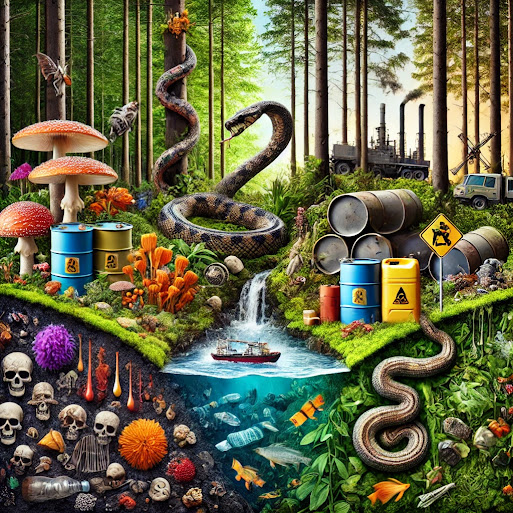Man-Made and Natural Poisons That Contaminate the Ground
Healthy soil is essential for sustaining plant life, filtering water, and supporting ecosystems. However, both man-made and natural poisons threaten soil quality and safety. Understanding these contaminants and their impact can help develop sustainable solutions for reducing soil pollution.
 |
| Explore the contrast between natural and man-made poisons in the earth, from toxic plants and venomous creatures to industrial pollution and chemical waste |
Man-Made Poisons in Soil
1. Pesticides and Herbicides
Agricultural chemicals such as glyphosate, atrazine, and neonicotinoids are widely used to control pests and weeds. However, these compounds can persist in soil, harming beneficial organisms, leaching into groundwater, and disrupting ecosystems.
2. Heavy Metals
Industrial activities, mining, and improper waste disposal introduce heavy metals like lead, arsenic, mercury, and cadmium into the soil. These toxic elements accumulate over time, poisoning plants and entering the food chain, leading to serious health risks.
3. Industrial and Household Waste
Chemical runoff from factories, oil spills, and improper disposal of batteries, electronics, and plastics release harmful substances into the ground. Pollutants like dioxins, PCBs, and microplastics degrade soil fertility and pose long-term environmental hazards.
4. Sewage Sludge and Wastewater Contamination
While treated wastewater and biosolids are often used as fertilizers, they can introduce pharmaceuticals, microplastics, and pathogens into the soil, contaminating crops and water sources.
5. Acid Rain and Airborne Pollutants
Burning fossil fuels releases sulfur dioxide and nitrogen oxides, which mix with moisture in the atmosphere to create acid rain. This leads to soil acidification, nutrient depletion, and heavy metal mobilization.
Natural Poisons in Soil
1. Heavy Metals from Geological Sources
Natural mineral deposits can release arsenic, lead, and mercury into the soil. While these elements occur naturally, disturbances like mining or erosion can increase their bioavailability and toxicity.
2. Mycotoxins and Plant Toxins
Certain fungi produce harmful mycotoxins that accumulate in soil, impacting plant growth and animal health. Some plants, such as black walnut, release allelopathic chemicals that inhibit the growth of surrounding vegetation.
3. Volcanic Activity and Natural Gas Leaks
Volcanic eruptions release sulfur, mercury, and arsenic into the environment, contaminating soil over vast areas. Naturally occurring methane or radon gas can also seep into soil, creating hazardous conditions for agriculture and human habitation.
4. Salt Accumulation in Arid Regions
In dry climates, natural soil salinization occurs due to high evaporation rates and low rainfall, leading to toxic salt buildup that damages plant roots and reduces agricultural productivity.
Sustainable Solutions to Prevent Soil Contamination
1. Organic and Regenerative Farming
Using natural pest control methods, composting, crop rotation, and cover crops can improve soil health while reducing reliance on harmful chemicals.
2. Pollution Prevention and Cleanup
Proper disposal of hazardous waste, industrial cleanup efforts, and phytoremediation (using plants to absorb toxins) can help restore contaminated soil.
3. Improved Waste Management
Recycling batteries, electronics, and plastics, along with treating wastewater before land application, can prevent soil pollution.
4. Monitoring and Soil Testing
Regular soil testing for heavy metals, toxins, and pH balance helps detect contamination early and guides corrective actions.
By addressing both man-made and natural soil contaminants, we can protect our land for future generations. Sustainable solutions not only restore soil health but also ensure safer food, water, and ecosystems.









Comments
Post a Comment